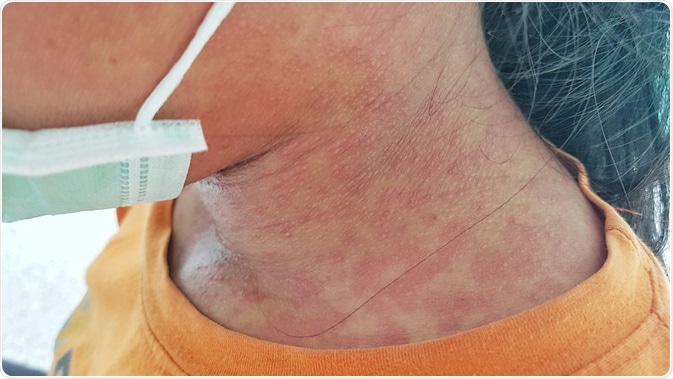Rubella, also known as German measles, is an acute viral infection that usually affects children and young adults. It is a contagious condition that can be transmitted between humans via airborne droplets when infected individuals cough or sneeze.
It is usually mild in children but can have severe consequences in some population groups, such as pregnant women. It has the potential to cause fetal death or birth defects to the infant. On a global basis, more than 100,000 babies are born with congenital rubella syndrome each year.
The infection is usually self-limiting and there is no specific treatment. The disease can be prevented, however, by vaccination.

Skin of rubella patient. Image Credit: Akkalak Aiempradit / Shutterstock
History
Friedrich Hoffmann, a German physician, first described a case of rubella in 1740. George de Maton suggested it was distinct from other diseases such as measles and scarlet fever in 1814. As each of the initially recorded cases occurred in Germany, the disease became known as “German measles.” The name rubella originates from the Latin word that means “little red,” which was first used in 1866.
Throughout the 20th century, medical research discovered that rubella was caused by a virus and could be passed on via airborne droplets. Research about congenital rubella syndrome began extensively following several cases arising from an epidemic infection in Australia in 1940.
In 1962, the virus was isolated in tissue culture, allowing the initial research for a vaccine to begin. A live attenuated virus vaccine was licensed in 1969 and introduced in combinations with other vaccines shortly after. The introduction of vaccination has greatly reduced the incidence of viral infection and it is considered rare among developed nations today.
Symptoms
The symptoms of rubella are usually mild and many patients may not be aware of the infection. The virus spreads in the body over the course of a week and symptoms may present 2-3 weeks after infection. Symptoms may include:
- Rash
- Low fever
- Nausea
- Mild conjunctivitis
- Swollen lymph glands
The rash affects most patients and appears initially on the face and neck region and progresses down the body, lasting for up to three days.
Adults with the infection tend to have more severe symptoms than children and may also develop painful joints that last for 3-10 days.
Congenital rubella syndrome
If a pregnant woman becomes infected with rubella, there is a high risk (approximately 90%) that the viral infection will be passed on to the fetus. This can cause miscarriage, stillbirth, or birth defects known as congenital rubella syndrome.
Children with the syndrome may suffer from a range of effects including:
- Hearing impairment
- Eye defects
- Heart defects
- Autism
- Type I diabetes mellitus
- Thyroid dysfunction
As a result of these effects, most children will require ongoing care on a chronic basis and some may need surgical procedures.
Prior to vaccinations for rubella, 4 babies in every 1000 births had congenital rubella syndrome. Vaccination has greatly reduced the incidence of the syndrome, such that it is considered to be rare in developed countries. Developing nations with poorer vaccination programs have the highest rates.
Vaccination
The rubella vaccination uses a live attenuated strain that provides more than 95% long-lasting immunity with a single dose, similar to the natural protection acquired when an individual is infected with the virus in childhood.
Some individuals may experience a mild reaction to the vaccination, such as local irritation at the injection site, low fever, rash, and muscle aches. Immunization has been used to protect millions of individuals from the disease and no serious adverse effects have been reported.
The vaccination is available as a monovalent formulation but is usually administered in combination with other vaccines for measles, mumps, and varicella.
References